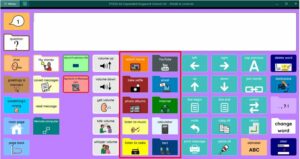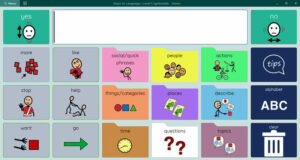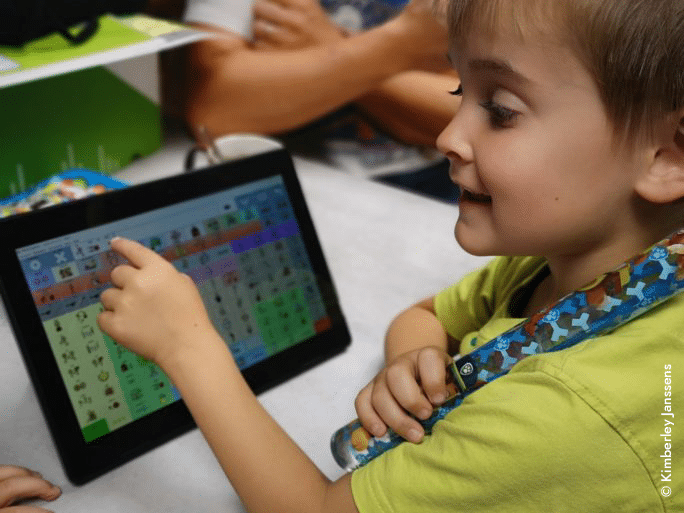Everyone has something to say, but what if you can hardly speak or not at all? You can use supportive tools, but how do you decide which communication strategy suits you best? Bottom-up or top-down vocabularies? And how do you start?
In this blog, we want to talk about vocabulary or strategies in Augmentative and Alternative Communication (AAC) and which robust systems exist in Mind Express 5. ISAAC-NF, the Dutch-speaking international community for AAC, describes the purpose of an AAC strategy as follows: “to strengthen, improve and/or extend the authentic communication of the person with a communicative disability by means of all communicative modalities, in all communicative functions”.
Everything revolves around that authentic, personal communication. It’s the only way you really get to know and understand each other. We would like to share a moving testimony of Dana Nieder, mother and author of the blog ‘Uncommon Sense’:
“My daughter, Maya, is almost 5 years old. She can clearly speak approximately 15-20 words.
With her talker (an iPad with a communication app) she can speak approximately 700 words, with thousands more available at the touch of a button if she needs them.
With her voice, she can say “Mommy” and “Daddy”. With her talker, she can tell me that today is Friday and she’s going to the therapy gym in the afternoon and she wants to ride on the big swing and the tire swing and do an art project.
With her voice she can say “bus.” With her talker, she can tell me who she sat next to at school and what they talked about and what she wants to have for dinner and whether she’s feeling tired or happy or cranky.
With her voice she tells me “no.” With her talker she tells me “No way, Jose.”
With her talker, she tells jokes and is sassy and is proud, so proud, to tell us things and to connect with us. If she only had her speaking voice, I would barely know her.”
Start with Augmentative and Alternative Communication (AAC)
So how do you start communicating when your daughter, your son, your pupil, your friend, your client, … doesn’t or barely speaks like Maya?
Novice or emergent speakers are a diverse group. One person will advance faster than the other. In spite of the differences, we also remark a number of similarities based on scientific studies and practical experiences (Zangari, 2014). For example, beginning speakers should start with a lot of verbs and nouns for 2 reasons. Firstly, they have a motivating effect. They provoke communication, you achieve something with them (e.g. ‘playing ball’). Surely you only want to (re)learn something when you see the added value of it? Secondly, nouns are very concrete, which speeds up the learning process. Admittedly, ‘dog’ is easier to understand than ‘mine’, isn’t it?
Having an alphabet at one’s disposal seems logical when there is an interest in letters and words, but even when that interest is not yet there, having letters at your disposal is useful. The diversity within the group of beginning speakers means that you can’t exclude anything. Therefore, offer it so that it can be explored. There is no guarantee of literacy but it lowers the threshold.
Exclude nothing, presume potential. Nobody is too young, too old, or too weak to start. Always assume that someone is able to learn. If you don’t try, how can you prove that someone is unable to communicate?
“There is no such thing as ‘too low to communicate’. And you must have words to prove you can use words” – Kate Ahern
Kate Ahern is a assistive technology specialist and special needs teacher.
Bottom-up communication
As a counsellor or parent, you can start by collecting words yourself. If it is on paper or if it is digitally, you can build your own communication pageset. Let yourself be inspired by your surroundings. Complete with names of family, friends, and peers, with favourite dishes, colours, places, or other subjects that are close to the user’s heart and are motivating to talk about. The main goal is to be a tool for self-expression and communication with the environment.
“He has been using a speech computer since he was six years old. For the first few years that was incredibly nice, Juul was finally able to let us know what he wanted to say. Juul speaks a limited number of words (such as mum, dad, bus, yes and no). When he does not have a word, he uses the word Peh. Not understandable for an outsider. With the help of his speech computer he could tell us which movie he wanted to watch, who he wanted to go to, what he wanted to play, what he wanted to drink, where he was in pain … It was also very nice for the teacher, family and babysitter. Juul was finally able to tell us something. He also felt much more understood and didn’t have to struggle for every word he wanted to say.
Last year it turned out that only the speech computer was not enough anymore. Juul wants to say so much! And I had to add everything myself in the communication file. Juul’s thinking pattern is much faster and he develops so many words in his head that I can’t follow it. Also, sometimes it takes a very long time before we understand which new word Juul means by Peh”. – Marleen Nulens-Zeeuwen about her son Juul (11 years old) and why they went looking for SCORE.
This is called a bottom-up approach because you make a basis and then expand it step by step. This makes you, as a parent or supervisor, familiar with the structure. This can sometimes make modelling easier. On the other hand, a bottom-up approach is very time-intensive, especially if you want to keep it motivating and up to date. It is impossible to add every conceivable word in the communication chart, so you choose the most logical words. Moreover, the words have to evolve along with it. You want a tool for today and tomorrow, but with symbols we don’t give them, they can’t use. They remain dependent on others for their communication (Gayle Porter, 2017, p. 21; ISAAC-NF, 2019).
Top-down or robust systems
It is quite a challenge, especially for non-therapists, to take all this into account. So it’s interesting to know that there’s also a top-down approach. These are communication pagesets or vocabulary based on research and/or practical experience. With this approach, you will also find many different strategies. Professor Dr. Carole Zangari (Speech language therapist) calls these robust systems. In 2009, Soto and Zangari (2009) sum up the most important elements of robust communication systems as follows:
- Enough words to be able to communicate in all kinds of situations; to be able to say what you want and when you want.
- Consists of core and fringe words. “They complement each other and need each other. Without core vocabulary no grammatical sentence can be made and without peripheral vocabulary, the sentence has no specific subject”. (manual ALOHA, p. 7).
- Access to all types of words: verbs, personal pronouns, nouns, adjectives, adverbs, etc.
- Pre-programmed sentences that are useful to be able to react quickly in a certain situation.
- Alphabet access with word prediction.
- Grammar support that allows for grammatically correct sentences.
- Offer opportunities to grow with the user.
Now we know what robust communication systems stand for and what they have in common. Of course, they also have differences. We, therefore, give an overview of the various robust symbol communication systems available for Mind Express: PODD, SCORE and Steps to Language.
For more information about the text-based vocabulary ‘Amego’, please visit our webpage.
PODD
PODD stands for Pragmatic Organization for Dynamic Display. Pragmatic organisation means that the symbols/words are organised for daily use. PODD is dynamic because there is room for personalisation. Display stands for the display of symbols.
The aim of PODD is to meet a person’s communication needs as comprehensibly, specifically, efficiently, independently, and socially accepted as possible. (Porter, 2017, p.9; 1997)
Origin
PODD was developed by Gayle Porter. She drew on her 30 years of practical experience as a speech therapist at CPEC (Cerebral Palsy Education Centre) and on scientific research. What was her motivation? AAC users should be able to say something when they want, to whom they want and with the words they want.
Use
The PODD books are available in a different number of cells per page and in both paper and digital versions. The use of paper and digital versions is not an ‘or-story’ but an ‘and-and’ story. For example, you can use the paper version when the digital version is difficult to use, such as in the bath or when playing outside. The digital PODD pagesets consist of:
- 15 preschool
- 15 preschool eyegaze
- 15 school
- 15 school eyegaze
- 15+ preschool
- 15+ preschool eyegaze
- 15+ school
- 15+ school eyegaze
- 60 expanded keyword school
- 60 expanded keyword school eyegaze
- 60 complex
- 60 complex eyegaze
These are the most recent Gayle Porter approved files with new features such as e-mail.
Thanks to the different books PODD can evolve along with it. Of course, the choice between different books may lead to choice stress… So how do you start with PODD? There is no minimum requirement to start with PODD, so the best advice is: just start. Just start using the book. Also, be patient, don’t offer the book until the user shows an interest in it. Keep in mind that it can take months or even years. This is the case with any AAC strategy. But building passive vocabulary is very important in AAC and anything but wasted time.
> Take a look at the PODD page for more info or the demo.
SCORE
SCORE combines core and fringe vocabulary in a unique way. The core vocabulary remains on each page and the border words are located in a dynamic block in the middle of each page. As a result, you do not need a home or back button and the organisation remains consistent. The goal is to find your words without thinking and without searching because your muscles remember where a word is (= motorplanning).
With SCORE you are fully committed to language development. The structure facilitates learning and encourages the user to experiment with language and communication.
Origin
SCORE was founded at the University of Cologne as a result of research into core vocabulary. This research shows that relatively few words are used very frequently. Approximately 200 words make up no less than 80% of the spoken language (Boenisch, Soto, 2015; manual SCORE).
Use
As with PODD, SCORE also exists in a paper and digital version. The organisation remains consistent so that you can easily use both versions next to each other, depending on the situation. The paper version has the following sizes:
- A4 – 40 keywords
- A3 – 40 keywords
- A3 – 108 keywords
- A0 / A1 wallpaper (140 / 336 cells)
- binder – 200 key words
The power-based pageset consists of a set with 1250 words to the extended version with about 3000 words in it. With the leaf set you also get the 2-step version of SCORE, specially adapted for alternative operation.
> Read more about SCORE here or try out the demo.
Steps to language
Steps to Language is a vocabulary package designed to support children to develop the skills needed for symbol-based communication. It has been specifically designed for children using AAC, right from the very beginning of their journey, moving towards developing complex language skills.
Origin
Steps to Language was developed by Sarah Alderman, a Speech and Language Therapist who has worked in the field of AAC over the past 10 years. It was designed to consider some of the stumbling blocks that children who use AAC frequently face, with a particular emphasis on the idea of linking words to make phrases. Research tells us that toddlers start to combine words when they have a foundation of 35-50 single words. Yet, children who use AAC may have a strong knowledge of many symbols but still find it difficult to move past using single words to form phrases. Steps to Language allows the opportunity to practice putting words together with visual prompts to encourage sentence formation.
Steps to Language also incorporates ideas from a range of speech and language approaches. The layout of folders was influenced by Colourful Semantics, an approach used to support children to develop sentence structures. Pragmatically organised AAC systems were also considered in order to encourage natural, social language and conversation.
Use
Steps to Language has 3 stages so that the child can gradually build their language skills in a similar way to how young children learn to talk. They initially need to learn to confidently use common words before we can begin to expose them to more difficult words and more complex sentences. The 3 stages reflect a child’s growing vocabulary, changing interests and development of literacy skills based on research.
> Do you want more information or try out Steps to language, please visit our webpage.
Conclusion
One vocabulary is no better than another, but it may fit better. What gives Juul sparkling eyes may not match with Maya and vice versa. The aim is to make that authentic communication possible, for today and tomorrow.
Inform yourself, contact us or a therapist for extra information or a demo, download the free trial version and see what matches. Go on and look out for those sparkling eyes!
Sources
Boenisch, J. & Soto, G. (2015): The oral core vocabulary of typically developing English-speaking school-aged childeren: implications for AAC practice. In: Augmentative and Alternative Communication 1/2015, 77-84.
Erickson K. A., & Clendon S.A. (2009). Addressing the literacy demands of the curriculum for beginning readers and writers. In G. Soto & C. Zangari (Eds.), Practically speaking: Language, literacy & academic development for students with AAC needs (pp. 195-215). Baltimore: Paul H. Brookes Publishing Co.
Manual ALOHA (in Dutch). http://www.mindexpress.be/img/handleiding_ALOHA.pdf.
Interactive manual SCORE (in Dutch).
ISAAC-NF. (2019). Leidraad Ondersteunde Communicatie. Oeffelt: International Society for Augmentative and Alternative Communication – Netherlands and Flanders. Downloadable on https://www.isaac-nf.nl/nieuws/onderzoek (Dutch).
Dutch magazine for logopedia, number 1 February 2017 year 89
Interview Gayle Porter over PODD en Autonoom communiceren, published on Jan 15, 2017 + https://issuu.com/response-able/docs/2017-01_interview_gayle_porter_logo.
Porter, G. (1997). Pragmatic Organisation Dynamic Display Communication Books. Introductory Workshop manual.
Zangari, C. (2014). Linguistically robust AAC systems. Visited on 30 July 2020 at https://praacticalaac.org/praactical/linguistically-robust-aac-systems/.





